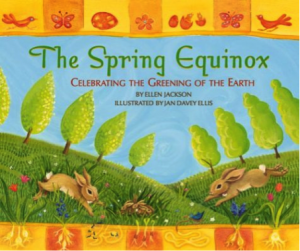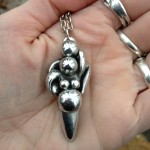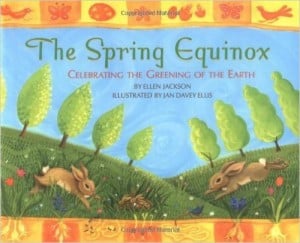By Meg Yardley
The Spring Equinox is a wonderful festival for celebrating the beginnings of spring with your family. This page suggests some ways for families to celebrate Ostara together. Hopefully at this time of year you are able to spend more time outside, as there is so much to discover and enjoy outside in the springtime, but on evenings and rainy days it’s great to have some picture books to curl up and read together.
In honor of the Equinox, you may want to seek out books related to:
- Spring – Libraries are full of wonderful picture books about springtime. I included a few below, but there are many, many more. It’s great to accompany these books with springtime walks to see what signs of spring are appearing around you, especially if you live in a climate with more dramatic seasonal changes.
- Growing and planting – Gardens, gardening, plants, and starting new projects are also timely themes for the Spring Equinox.
- Balance and opposites – The equinoxes are good times for thinking about day and night, dark and night, warm and cold. One special thing about modern Pagan traditions is that we generally value both sides of a duality and explore how both sides are important. For toddlers, there are some wonderful picture books about opposites, which show wet/dry, hot/cold, and so on.
- New beginnings – Books about trying new things, changing habits, and travelling to new places are a wonderful fit for this time of the year, when seeds are sprouting and energy increases with the longer days.
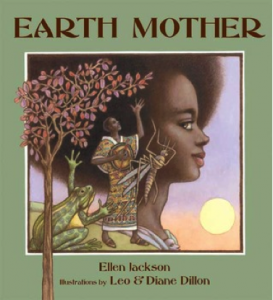 Earth Mother, by Ellen Jackson, illustrated by Leo and Diane Dillon
Earth Mother, by Ellen Jackson, illustrated by Leo and Diane Dillon
Admittedly, I’ll read just about anything illustrated by Leo and Diane Dillon, but this one is definitely a gem to include in your Pagan family’s library. As Earth Mother goes through her day (doing things like fanning smoke in the four directions and spangling trees with fireflies), she encounters Man*, Frog, and Mosquito. Each of them has something to be grateful for and something to complain about and feels that if Earth Mother could just make more of the good and less of the bad, the world would be “perfect.” But it’s not so simple: although Mosquito may seem bad to Man, she seems delicious to Frog; and although Frog may seem tasty to Man, he is a predator to Mosquito! Perhaps Earth Mother’s system is “perfect” after all. You’ll be captivated by the luminous, detailed illustrations featuring a tall, stately, dark-skinned Earth Mother. The words are simple enough to read to a younger child, while an older child may see the humor in the different creatures complaining about each other. For toddlers and up.
*I was surprised to see such a recent book using the term “Man” to represent humankind, although when I read it to my daughter as “Human”, I had to admit it wasn’t a very graceful alternative.
Pagan Notes: My child came in as I was writing this and, seeing the book’s image on the screen, commented, “Guess what? Earth Mother is the goddess of everything.” I think that about sums it up.
The Ugly Vegetables, by Grace Lin 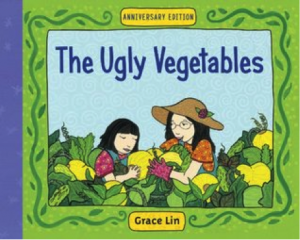
A favorite in my house. The young narrator helps her mother plant and tend a garden, but she is not happy to realize they are only planting “ugly” Chinese vegetables, while all their neighbors are growing beautiful flowers. But when the vegetables finally make their way into her mother’s soup, the aroma is so delicious that neighbors line up at their house to taste the soup. This story offers a gentle window into the larger conflict of assimilating into the dominant culture vs. honoring diverse cultural heritages – here with a win-win solution. For older toddlers and up.
Pagan Notes: Although this story ends with the harvesting and eating of the vegetables (probably summer), the focus is on the springtime beginnings of the gardens, and I love how it captures the world coming alive and growing in spring.
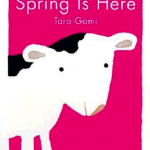 “Spring is Here,” by Taro Gomi
“Spring is Here,” by Taro Gomi
A sweet board book which starts in Spring and takes us through the changing seasons with descriptions like “The grass sprouts.” and “The quiet harvest arrives.” It ends with a new Spring and we see that the calf has grown up. In addition to the lovely illustrations, there is a playful visual device where the calf’s fur turns into the land where the seasons are changing. Toddlers and up.
Pagan Notes: I think the description speaks for itself!
“The Boy Who Didn’t Believe in Spring,” by Lucille Clifton, illustrated by Brinton Turkle 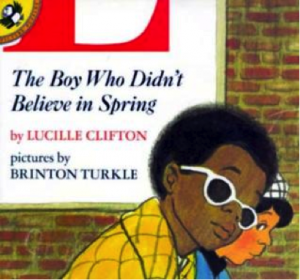
Poet Lucille Clifton skillfully spins a story starring a boy named King Shabazz (yes, this book was written in 1973), who doesn’t believe in Spring and says “No such thing” whenever adults talk about it. Finally, though, he gives in to curiosity: “’Everybody talkin bout Spring comin, and Spring just round the corner. I’m goin to go round there and see what do I see.’” As he and his best buddy Tony travel through the city streets, they find sweet signs of Spring in a very unexpected place. Preschoolers and up.
Pagan Notes: City dwellers will appreciate this tale of seeking (and finding) nature’s mysteries in an urban environment. Also, the boys’ journey to find spring reminds me of the theme of new beginnings associated with the Spring Equinox: as Tony and King travel outside their comfort zone (they’ve never gone this far alone), they are rewarded by a magical experience. (And then they get called back to reality, as we usually do!)
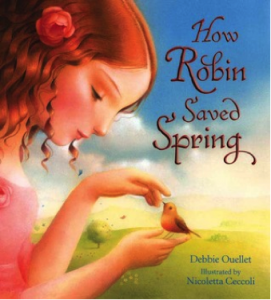 How Robin Saved Spring, by Debbie Ouellet, illustrated by Nicoletta Ceccoli
How Robin Saved Spring, by Debbie Ouellet, illustrated by Nicoletta Ceccoli
(Out of print – check used bookstores online to find a copy.) Lady Winter wants to prevent spring from coming so that her reign will never end, so she knits a magic blanket of sleep to keep Sister Spring from awaking. Various animals try different schemes to wake up Sister Spring, but none are successful until Robin comes up with a brave and daring plan. This tale explains many animal and plant characteristics (for example, bear hibernates in winter because Lady Winter put him to sleep for meddling in her plans). As you see from the cover, this book features bright, gorgeous illustrations that bring the characters and the story to life. Note that Lady Winter is not very nice and can be a little scary. This is a fairly wordy story, suitable for older preschoolers and up.
Pagan Notes: This book was a hit with my child and Lady Winter and Sister Spring more or less attained goddess status immediately. It’s a well-told and dramatic story. I love the way this tale illustrates the feeling that winter could go on forever. Also, I like how the animals work together to try and outwit Lady Winter. My main philosophical disagreement was that you come away with the feeling that Winter is not very nice. I’d like to send the message that Winter and Spring both have an important role to play in the Wheel of the Year (just as day and night are both important, planting and reaping are both important…).
Mirandy and Brother Wind, by Patricia C. McKissack, illustrations by Jerry Pinkney 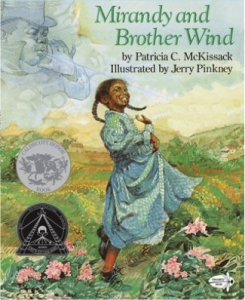
The book begins: “It was Springtime, and Brother Wind was back. He come high steppin’ through Ridgetop, dressed in his finest and trailing that long, silvery wind cape behind him.” Mirandy is determined to get the wind to be her partner for the cakewalk dance, despite the teasing of her clumsy friend Ezel… but it turns out it’s not so easy to catch the wind! With a little magic, a lot of determination, and some good timing, Mirandy finds herself a very special partner for the cakewalk. For older preschoolers and up.
Pagan Notes: This high-spirited story is all about spring fever. I love how the illustrator’s vivid imagination brings Brother Wind to life, and the solution to Mirandy’s dilemma is very magical as well (I won’t spoil the surprise for you). As a side note, the story also features a kindly conjure woman who is slightly disapproved of by the town, but friendly and helpful to Mirandy.
The Spring Equinox: The Greening of the Earth, by Ellen Jackson, illustrated by Jan Davey Ellis
I’ve written in earlier posts about this series, so my other comments apply here as well. This book describes the season of spring and the ways different cultures have celebrated spring and planting seasons in the past and present.
Pagan Notes: This book always makes me wish I celebrated Maslenitsa, the Russian pancake festival! Anyway, at the end of the book is an illustrated story about the goddess Ostara which helped to make the Spring Equinox holiday more “real” to my child.
Meg Yardley is a Pagan and a parent of two young children, living in the San Francisco Bay Area. She sings with the Turning Earth Singers, a Pagan music ensemble which recently led a “Pagan Kids’ Song and Story Time” workshop. She appreciates pictures books as a wonderful spiritual practice parents and young children can share.
Editor’s Note: You can find books reviewed at Pagan Families in our Amazon store.

